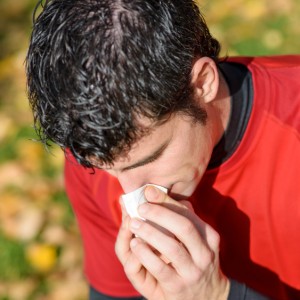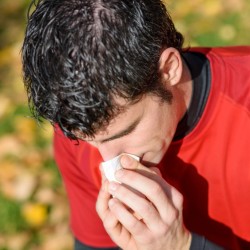Abstract / The common cold is one of the most frequent illnesses caused by viral infection. Recently, our research reported that oral administration of cystine  and theanine (CT) to mice enhanced the humoral immune response associated with antibody production. Based on this mouse study, we investigated the effects of cystine, theanine and the common cold in humans as a pilot study. By Shigekazu Kurihara, Takenori Hiraoka, Masahisa Akutsu, Eiji Sukegawa, Makoto Bannai, and Susumu Shibahara, published in J of Amino Acids, Vol, 2010, ID 307475
and theanine (CT) to mice enhanced the humoral immune response associated with antibody production. Based on this mouse study, we investigated the effects of cystine, theanine and the common cold in humans as a pilot study. By Shigekazu Kurihara, Takenori Hiraoka, Masahisa Akutsu, Eiji Sukegawa, Makoto Bannai, and Susumu Shibahara, published in J of Amino Acids, Vol, 2010, ID 307475
Cystine, Theanine and the Common Cold
The common cold, an acute infection properly known as “cold syndrome,” is the most common human illness. The majority of cases of cold syndrome are acute infections of the upper respiratory tract, and its major cause is viral infection. From 30 to 50% of cases of cold syndrome are caused by rhinoviruses, and 10 to 15% are caused by coronaviruses. Conventional methods of treatment use medications, such as analgesic agents and antihistamines, but these are only eff ective for the alleviation of symptoms, such as sneezing and runny nose. Furthermore, antiviral agents, such as neuraminidase inhibitors, are believed to be effective; however, their application is currently limited to the influenza virus. Chinese medicine and dietary supplements have attracted attention as effective new methods for the treatment and prevention of cold syndrome; for example, vitamin C; allysine, which is found in garlic; and the extract of the natural herb Echinacea.
However, there have also been reports indicating that the incidence of cold syndrome is unaffected by the above treatments, and thus their effectiveness has yet to be clearly demonstrated. In a previous experiment in mice, we revealed that the oral administration of L -cystine and L -theanine (CT) reinforced antigen-specific antibody production after antigen stimulation; these effects were possibly caused by the reinforcement of glutathione (GSH) synthesis and the humoral immune response [13]. Based on previous reports, the objective of this pilot study was to evaluate the effects of CT against cold syndrome in humans, using a double-blind comparative study.
The subjects (176 Ajinomoto Co. employees, all healthy males) were randomly allocated into one of two groups using an allocation table: a group receiving placebo (P) and another group receiving cystine/theanine (CT). Both groups were studied at the same time. Before the test, we determined the number of subjects with allergy symptoms, the number of smokers, the number of subjects who caught a cold twice or more per year, and the number of subjects living with schoolaged children, which are the family members most likely to catch a cold.
The applied dose in the present study was set at 700 mg/day for L -cystine to remain within the range of the average daily intake of L -cystine or L -cysteine. The applied dose of L -theanine was calculated as 280 mg/day based on analyses in mice, which suggested that the most effective weight ratio of cystine : theanine = 5 : 2. Glycine was used as a placebo so that the subjects received the same source of nitrogen, and the applied dose was set at 980 mg/day.
The onset of common cold symptoms as well as data regarding intake of the test meals during this 5-week period were recorded by the subjects on a daily basis as described below. The subjects performed a self-evaluation of 19 symptom items (“symptoms of the common cold”: runny nose, stuff y nose, sneezing, sore throat, cough, sputum, chills, fever, headache, joint pain, pain in the skin, and general malaise; “adverse events accompanying test meal ingestion”: nausea, vomiting, abdominal pain, diarrhea, loss of appetite, chest pain, and skin rash ( +: presence of symptoms, °æ : slight symptoms, and − : absence of symptoms).
Effectiveness
 As shown in Figure 1 (see the full study), the incidence of the common cold in the CT group was lower than in the P group throughout the 5-week period of the trial. As shown in Table 5 (see the full study), the incidences of the common cold according to the definition set by our laboratory were 11.4% in the CT group and 27.1% in the P group, with that in the CT group being significantly lower than that in the P group (P = . 011).
As shown in Figure 1 (see the full study), the incidence of the common cold in the CT group was lower than in the P group throughout the 5-week period of the trial. As shown in Table 5 (see the full study), the incidences of the common cold according to the definition set by our laboratory were 11.4% in the CT group and 27.1% in the P group, with that in the CT group being significantly lower than that in the P group (P = . 011).
The cumulative incidences during the trial period were 10 in the CT group and 29 in the P group (in the placebo group, four subjects had two and one subject had three separate instances of colds during the trial period); the CT group demonstrated a significantly reduced number of colds than the P group (P = .002). In addition, the cumulative numbers of days affected by the common cold were 18 days in the CT group and 59 days in the P group; the CT group demonstrated significantly fewer days affected by the cold than the P group (P = .002). The average duration of the colds was approximately 10% less in the CT group than that in the P group, although this difference was not significant.
CLICK HERE TO READ THE FULL TEXT ARTICLE





